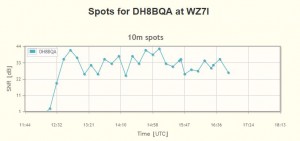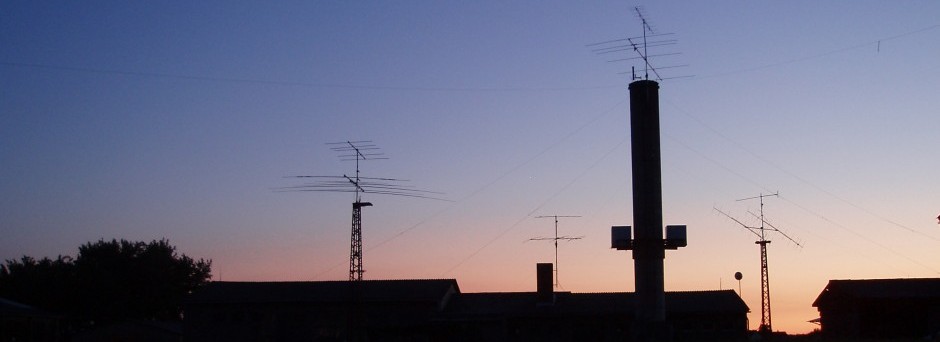Moving house is slowly taking over priorities overhere so as sad as it is seeing the still good condx I decided to skip the ARRL-10M next weekend and concentrate on moving things over to the new house. Uwe, DL3BQA, will step in instead. Keeping fingers crossed he can make something out of it, propagation forecasts for next weekend look good. 😉
Not to miss the radio feeling I at least spent some time yesterday in the 10M-RTTY contest. It is quite unique in allowing just 100 watts output max. Sorrily activity in this one is not very high. I did some 70 QSOs using low power first but after lunch decided to go high power, i.e. switch on the KPA500 for about 600 watts output. Thus my log does only qualify for a checklog but running with high power *is* simply more fun. 😉 Condx were not as good anymore as last weekend (plus distortion due to Aurora again) but still allowed a reasonable QSO total of 350 RTTY QSOs in a bit more than 8 hours overall operating time.
 It’s a pity there are not more RTTY skimmers yet. WZ7I in PA, U.S. east coast, was the only one across the pond spotting me yesterday. Analysis of it’s spots on the reversebeacon.net website (see screenshot left) nicely shows how the band opening evolved. Wesley’s skimmer saw me at 11:52z for the first time with -3 dB. That was the same time I worked my first U.S. station with K5ZD calling in on skewed path beaming the Caribbean for best signal strength. A few more “-” spots followed until 12:22z the first +3 dB spot that can also be seen on the screenshot. That was the time I swung the beam direct path! It took another 10 minutes until the first reasonable signal strength spot with 20 dB. Another 10 minutes later the band was finally well open. The last spot shown is 16:54z at 27 dB, afterwards the band rapidly closed. I was seen a single time again half an hour later at -2 dB.
It’s a pity there are not more RTTY skimmers yet. WZ7I in PA, U.S. east coast, was the only one across the pond spotting me yesterday. Analysis of it’s spots on the reversebeacon.net website (see screenshot left) nicely shows how the band opening evolved. Wesley’s skimmer saw me at 11:52z for the first time with -3 dB. That was the same time I worked my first U.S. station with K5ZD calling in on skewed path beaming the Caribbean for best signal strength. A few more “-” spots followed until 12:22z the first +3 dB spot that can also be seen on the screenshot. That was the time I swung the beam direct path! It took another 10 minutes until the first reasonable signal strength spot with 20 dB. Another 10 minutes later the band was finally well open. The last spot shown is 16:54z at 27 dB, afterwards the band rapidly closed. I was seen a single time again half an hour later at -2 dB.
So the skimmer spots nicely confirm what I had learned during the last few years already concerning the DL – NA openings: The band opens skewed path beaming South America and/or the Caribbean with weak signals about an hour before it is open direct path. Interestingly it’s the same from the other side of the pond as I learned during my visit to Carol, N2MM, during WPX-SSB earlier this year. There you have to beam to Africa to hear the first European signals before the band finally opens. So the scatter reflection zone seems to be somewhere over the Atlantic Ocean half-way between Portugal and the Caribbean …
The direct path opening takes about 20-30 minutes to evolve into full signal strength. And after the opening the band closes almost abruptly. Usually backscatter signals vanish about an hour or so before the band closes although DX signals are still strong (this cannot be seen from the data above, of course). The variation in signal strength has different reasons. One is QRM that lets the skimmers think the noise level is higher thus the SNR shown in the graph will drop. Another one is the shifts in propagation and corresponding reflection elevation angles. This is were a stack with switchable antennas would come in handy. 😉 And third there might be a bit of variation due to antenna direction. I.e. around 15:30z +/- I did turn the antenna a bit more north (295° to 310°) as the U.S. mid-west opened. With a 6L yagi it might already have an influence although beam-width is broad enough to not show it like that. So possibly rather a combination of all 3 factors that came into play then.
Of course one has to pay attention to not over-analyze things. 😉 But sure enough skimmers are a great tool to learn and/or confirm certain things. Thus let me take the opportunity to say a big “Thank you guys!” to all of you spending time and money to make those tools available to the public!
